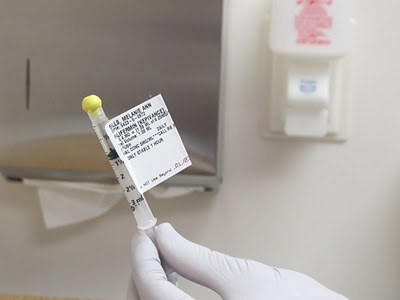Kepivance Side Effects
 Serious Side Effects of Kepivance
Serious Side Effects of Kepivance
- elevated temperature or a fever
- reactions in the mucus membrane or skin: hives, rashes, inflammation, or strange feelings in the mouth, tongue swelling or discoloration, or taste change
- swelling of the hands, feet or face which may indicate proteinuria (raised amounts of protein in urine), which can be a sign of kidney disease
- increase of blood enzymes in the pancreas (hyperlipasemia)
- allergic reaction: tightness in chest, itchiness, rashes, swelling of the lips, mouth, face or tongue, or difficult breathing
Common Side Effects of Kepivance
- pain in joints
- tenderness and swelling
- raised blood pressure
- numbness or tingling around the mouth
Warnings & Recalls for Kepivance
In May of 2009, the FDA modified the "Precautions" section for the Kepivance label to state that Kepivance may interact with heparin. If heparin is used in your I.V., flush the I.V. with saline to avoid any adverse reactions this combination may cause.
Kepivance is listed by the U.S. Food and Drug Administration as a pregnancy Category C medication. If you are pregnant, planning on becoming pregnant, or breastfeeding, it is important to consult your doctor before using Kepivance. It is unknown if Kepivance will harm the fetus, or if Kepivance may be transferred through breastmilk. Clinical trials in animals show that when used in pregnancy, Kepivance may decrease the weight of the fetus.
Before taking Kepivance let your doctor know if you are allergic to any products made with E.Coli proteins.
If used for non-blood related cancers, Kepivance may increase the risk of developing a tumor.
Kepivance Treatment and Use
Kepivanace | Palifermin is marketed by Biovitrum as a human keratinocyte growth factor (KGF) generated through the joining together of two different species of DNA cells (recombinant DNA technology). Kepivance is used to treat the following conditions:
- Decrease the risk of ulcers or sores developing in the mouth
- Reduce the occurrence of ulcers and sores in blood cancer patients who have undergone chemotherapy or radiotherapy before receiving bone marrow transplants
- Side effects or mucositis
How Does Kepivance Work?
Palifermin, the active ingredient in Kepivance causes the epithelial cells in the lining of the mouth and gastrointestinal tract to develop. In patients undergoing chemotherapy, these cells do not reproduce as quickly, leaving these areas susceptible to ulcers or sores. By triggering the growth of epithelial cells, Kepivance prevents and treats certain side effects of chemotherapy.
How is Kepivance Given?
Kepivance is an intravenous (I.V.) infusion given to patients 3 days before and 3 days after chemotherapy. Normally, a doctor or nurse administers Kepivance to patients, however, patients may be asked to use Kepivance at home, and will be given precise instructions on the preparation, dosage, use and storage of this medication.
Kepivance should not be administered to patients within 24 hours before or after chemotherapy.
Other Names for Kepivance
Brand name:
Generic name (Unavailable):
Lawsuits & Legal Information for Kepivance
Author:
Lauren Cohrs
Posted on Jul 13, 2012
 Serious Side Effects of Kepivance
Serious Side Effects of Kepivance